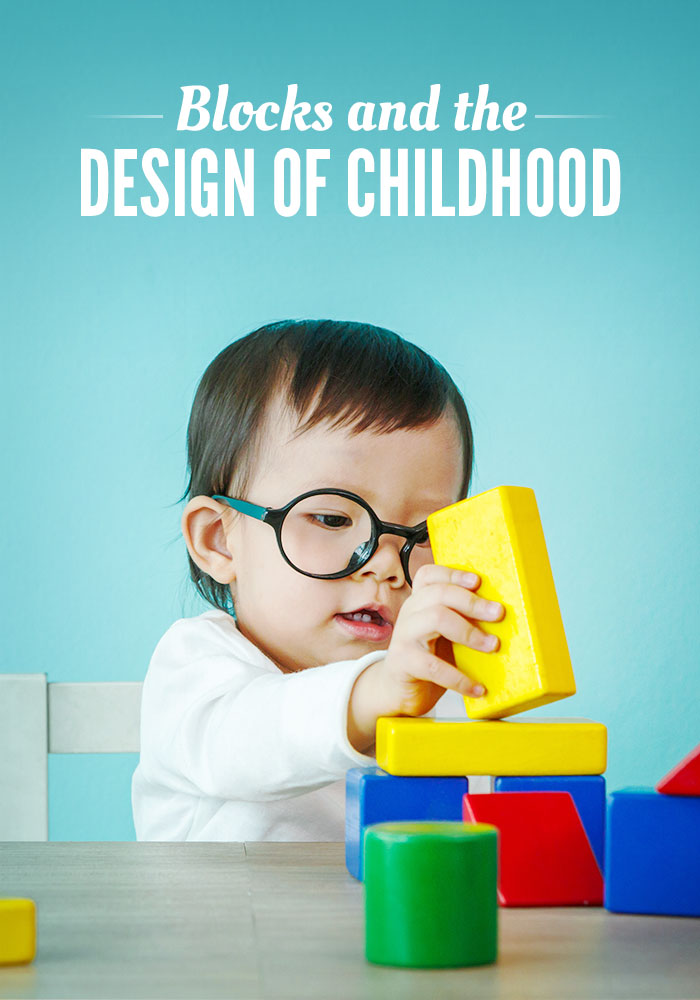
The Design of Childhood is the kind of book that brings sunshine to your heart on rainy day. The author, Alexandra Lange, is an architecture and design critic, a historian, and a mother. In her book, she draws from each of these core aspects of herself in an illuminating exploration of the material world that children inhabit.
As she writes in the first few pages of the book, “to have a child is to be thrown suddenly, and I found rather miraculously, back into the world of stuff. Dirty stuff, clean stuff, sleepy stuff, heavy stuff.” Lange is the kind of adult who pays close attention to children and who takes children seriously as persons and citizens. You can see this attentiveness present even in Lange’s description of how the book developed: “I studied the landmarks of my son’s territory as it grew from rug to house, school to playground to the whole city (under my supervision).”
The Opportunity of Play
Loving attention toward a child engaged with the material world is the origin and bedrock of education, according to Lange. (Here I am reminded of that stunning line from the philosopher Simone Weil that “attention is the rarest and purest form of generosity.”) Lange writes that “Progressive education in the United States and Europe – education not based on the primer and the lash – begins when a teacher places a block before a child and watches what happens.”
Lange explains the significance of the child playing with blocks, calling this play an opportunity to learn the “elements in the grammar of nature,” elements that need to be “touched, stacked, dangled, and rearranged in order to learn about geometry, gravity, time, and symmetry.” Lange quotes Ann Hulbert, literary editor, who describes the child as “an independent experimenter investigating a world of objects, solving the epistemological problems of space, time, causality, and categorizing,” which is as great a description of the child as budding philosopher as I’ve encountered.
Imagination & Creativity
One of the reasons that Lange is such a fan of kids playing with blocks is that this kind of play provides opportunity for imagination and creativity. In lovely prose, she explains that “many of our longest-serving toys have no baked-in narrative. Simple shapes and sturdy materials encourage free play and meet the child at her level. She may get in the box, color the box, cut the box, stack her box with a friend’s.” I really like this language of toys that do not stifle the imagination with baked-in narratives. I get the sense that when parents bemoan “electronics” what they are really rebelling against is the (very wrong) idea that kids can only entertain themselves when the toys they are playing with give them explicit parameters for that play.
Treat Children as Citizens
Likewise, Lange warns that “our built environment is making kids less healthy, less independent, and less imaginative. Instead of toys that tell kids what to do with them, Lange says that “what those hungry brains require is freedom,” and that requires the rest of us to treat children “as citizens, rather than as consumers.” To treat children as citizens means to make available to them “elements children can pick up and transform into environments themselves” with the understanding that “children are the designers here.”
As a brief aside, it’s worth mentioning that the critique of electronic toys and overly built play environments also has implications for social class structures. Throughout Lange’s book, she sneaks in commentary on how parenting fads, which often involve increased expenditure on kids, tend to originate in upper classes before becoming normative for everyone else. The downside to this, of course, is that families which can’t afford to ‘keep up with the Jones’ can feel guilty, as though they are failing their kids. Lange’s book should help to assuage that unnecessary guilt. And if her book isn’t enough, consider this statement from the American Academy of Pediatrics’ report “The Power of Play” “children’s creativity and play is enhanced by many inexpensive toys (eg, wooden spoons, blocks, balls, puzzles, crayons, boxes, and simple available household objects) and by parents who engage with their children by reading, watching, playing alongside their children, and talking with and listening to their children. It is parents’ and caregivers’ presence and attention that enrich children, not elaborate electronic gadgets.”
Is There Worth in Video Games?
Nevertheless, while the above paragraphs might suggest that Lange is opposed to digital games, nothing could be further from the truth. In fact, Lange sees games like Minecraft, which is literally a block-building game, as being analogous to physical block play. For example, she writes:
Today the sandbox is as likely to be the rectangular space of the computer screen, where digital sand, in the form of Minecraft cubes or Scratch block commands, are used to explore building, civilizations, and geography. [. . .] video games played in sandbox mode, or purpose-built sandbox games, allow the player access to the whole world (the box) at once, and allow her to change that world at will (the sand). There is no preset narrative to force the player to run, hide, or shoot, and no marauders to destroy what she has built. Time is her own. The pleasure is in the creation. [. . .] just as you shouldn’t assume all blocks are the same, you can’t assume all digital games are the same. [. . .] the material is only one aspect of a larger play experience, which may or may not be moderated, scaffolded, or undermined by adults.
Here’s the advice Lange gives on evaluating all play, digital or physical: “To understand the roots of a toy – wood, plastic, pixels, or a hybrid thereof – you have to see its potential in a child’s hands. To understand what children can do, you need to give them tools and experiences that are open-ended, fungible: worlds of their own making.” In addition to Minecraft, another series of digital games that arguably fit Lange’s description are the SimCity games which allow players to design and build cities from scratch. (Here’s a really cool article on what happens when a real city planner plays the game and innovates using his math skills.)
Building Toy Recommendations
At the end of her chapter on blocks, Lange mentions that when she was researching for the book, people often asked her recommendations for building toys. She writes:
“my short list includes Duplo, LEGO’s younger sibling…Tubation, a set of straight, L-, T-, and X-shaped tubes that can be connected into marble runs, musical instruments, and animal skeletons; Magna-Tiles; and Zoob.”





Hello
Buy all styles of Oakley Sunglasses only 19.99 dollars. If interested, please visit our site: designeroutlets.online
Thank You,
Demme(Home) – Demme Learning